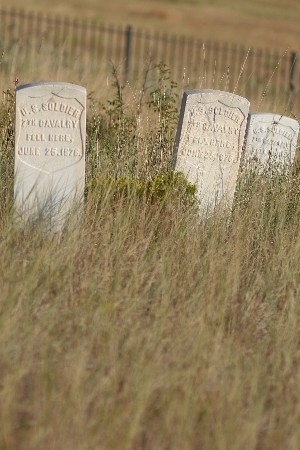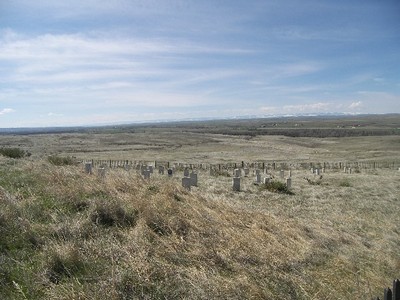The Battle of the Little Big Horn (or Custer’s Last Stand) took place on June 25th and 26th of 1876, 132 years ago this week. When I was a boy one of my cousins had a huge painting on the wall of his bedroom depicting some artist’s rendition of Custer’s Last Stand. I didn’t visit there too often, but I was always fascinated by the picture, and would spend a long time studying it each time, moving out from the main action — Custer standing tall in his buckskins and with saber raised in one hand while the other held his pistol reversed like a club — to the other desperate confrontations that spread edge to edge across the canvas; Indians swarming and shooting, soldiers falling, some already stripped or being scalped. It was a rendering from the artist’s imagination, of course, but it obviously fired an interest in me for the history of the battle. Something about the desperateness and the inevitable defeat also had an impact on a young mind that until that time had seen only glorious images of warfare.
Later when I was in college I took a series of elective courses “taught” by author, poet and historian John G. Niehardt. Niehardt had been dead for a few years by the time I took the classes, but the University of Missouri had filmed his lectures and used these and his books as the source material. We read his classics, Black Elk Speaks and When the Tree Flowered, and his epic poem, Twilight of the Sioux (nearly 300 pages!) which included Indian accounts of the battle of the “Greasy Grass” and later the messianic millenarianism of the Ghost Dance movement. It was a fascinating diversion from my other studies and while I didn’t (and don’t) embrace the attractive mythology of the “Noble Savage” as some might have, it did help me picture the humanity of the Sioux and other Plains Indians, with all the good and bad that comes with that.
A few years ago my family took a two-week, multi-state driving vacation across the West and I at last had the opportunity to visit the famous battleground in Montana. After having heard and read (and seen so many bad movies) of the battle I was expecting to be a little underwhelmed by the reality. Instead I was mesmerized by how well the area had been preserved and made into a national park. You can follow a road from place to place throughout the battlefield, easily following the course of the battle across the bluffs and ravines of the valley of the Big Horn. The 7th Cavalry soldiers were buried where they fell when the other troops arrived two days after the battle. When the bodies were recovered a few years later for re-burial, individual markers were placed for each, in some cases even providing the name and rank of the man who fell there.

Because the battleground is so preserved you can understand how manageable the size of the Indian camp (obscured by a stand of trees) may have appeared to Custer from his initial vantage point, and experience for yourself (almost) the shock Reno had to of felt when he led his force along the river and around those trees only to suddenly see thousands of teepees. Besides the soldiers’ markers, historians have also been able to survey the battleground in detail after a massive grass fire cleared the area down to the ground in the 1980s, revealing artifacts and human remains and even making it possible to track individual weapons (identified by their spent cartridge casings) as they moved around the field. You can follow the main body of Custer’s troops after the initial attack as they fought their way westward along a ridge (individual markers along the way) to “Custer Hill”, the site of the the famous “last stand” where they fell to the last man.

The last stand on Custer Hill. Lt. Col. George A. Custer’s marker is the one with the black background.
The day we were there it was incredibly hot; the car thermometer registered an outside temperature of 105 degrees. My wife and daughters were more interested in staying in the car than in understanding the place. Frankly, I could feel the sweat rolling down my face and between my should-blades as I stood at various locations, but I couldn’t help but feel the weight of the history as well as I slowly turned my head to scan each panorama, picturing myself in the midst of the markers, seeing nothing but roiling clouds of dust and Sioux surrounding me. It’s mind-bending (or it could have been incipient heat stroke). I highly recommend making the stop if you’re ever in the vicinity.
I’ll also recommend the video below. The song is “The Song of Crazy Horse” and is from an album that I had in college. The ballad itself took up the whole first side of the album, and is only excerpted in this video, though it was obviously created with some love by the YouTube submitter. The song has always stirred me, even though some of the lyrics aren’t up to the caliber of the story. The imagery, however, and certain musical passages have long been grooved in my memory. It’s certainly not one of the better chapters of our history (and I don’t mean the battle itself) but it’s certainly worth remembering, even 132 years later.












Very nice.
Did you get to the North Dakota Custer sites? Specifically, Custer commanded Ft Abraham Lincoln near Bismarck at the time, and rode west to Montana from there.
Their route pretty much followed present-day I94. Near Medora, there’s some sandstone rock where a couple of Custer’s troopers carved their names as they passed through the area.